Diamonds
|
||
|
||
Diamonds
|
||
|
||
 |
|
May 15, 1971: Location shooting began at the Elrod House in Palm Springs where Bond battles Bambi (*Lola Larson) [credited to Donna Garrett] and Thumper (Trina Parks) before rescuing kidnapped millionaire Willard Whyte, played by American country singer Jimmy Dean. The futuristic building was designed by John Lautner (1911-1994), who had been apprentice to influential American architect Frank Lloyd Wright (1967-1959). The Elrod House incorporated a large natural rock outcrop at the edge of the room, creating the impression that the fabric of the building is fused with the rock itself, and could have easily have been designed by Ken Adam. The polished aluminium and glass structure with adjoining swimming pool was very much in the style of Adam’s distinctive sets featured in four of the six previous James Bond films. *Lola Larson was in fact a stage name/pseudonym used for the Olympic gymnast Mary Hiller, who wished to remain anonymous at the time. |
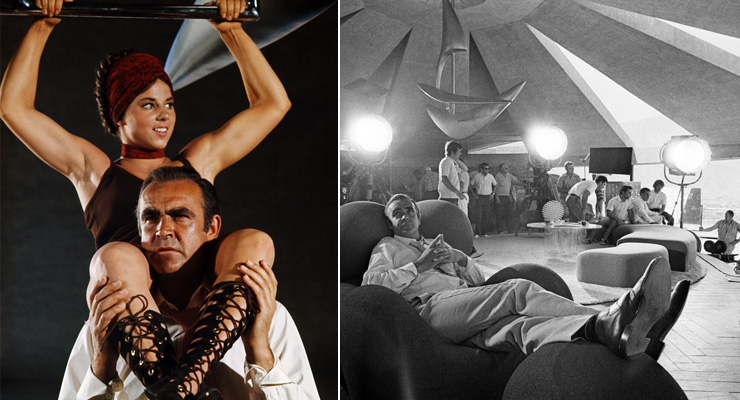 |
|
American location shooting concluded with the footage required for the film's climax at a disused oil rig at Oceanside, California. With the oil rig wired up for all kinds of pyrotechnics as helicopters attack, a misunderstanding led to the assistant director triggering the explosions on a dry-run. Fortunately the cameraman in the lead helicopter had started filming and much of the action captured for this sequence was from the accidental first take, as the rig could only be destroyed once. With filming in the USA complete, the cast and crew flew to the UK to begin shooting on Ken Adam’s sets constructed at Pinewood Studios. Several scenes had already been shot with Sean Connery while the crew completed the location work in the USA. One of those few scenes lifted directly from the Ian Fleming novel was the finale aboard the ocean liner Queen Elizabeth where Bond despatches Wint & Kidd, although their deaths were changed somewhat from the novel. The exterior of the ship (actually the P&O cruise ship Canberra) was shot on July 15, 1971 at Southampton docks. Sean Connery then flew to Nice to undertake one day's filming in Antibes, which would appear in the pre-credit sequence when Bond ‘throttles’ ex-Miss World 1953, Denise Perrier, with her bikini top during his hunt for Blofeld. Although uncut in 1971, this was one scene that would later trouble the British Board of Film Classification when the film was submitted for a home entertainment release in 2012. |
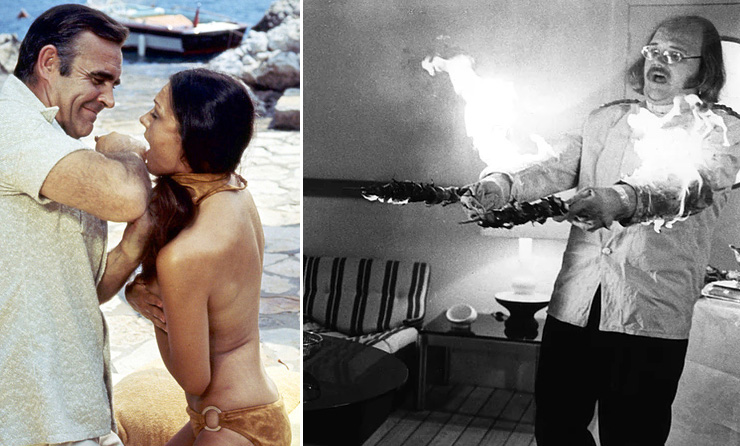 |
|
The fight in a lift between Bond and Peter Franks was one of the scenes trimmed by the BBFC in order to achieve the films ‘A’ certificate in 1971, and often cut further on television. This sequence was filmed at Pinewood Studios starting on July 25, 1971 with Sean Connery and Joe Robinson performing the majority of the fight (choreographed by long-time Bond stunt co-ordinator Bob Simmons and Gerry Crampton) in the confined space themselves. The cabin interiors for the finale of the film were then shot on August 2nd, with Putter Smith having his arms set on fire before stuntman George Leech took over to perform the full body burn and jump overboard. Leech actually had his wrists badly burned whilst performing this risky sequence. The fire stunt was one of the many scenes in the film later deemed gratuitously violent in such a jokey sequence, and consequently also often trimmed in later TV screenings. |
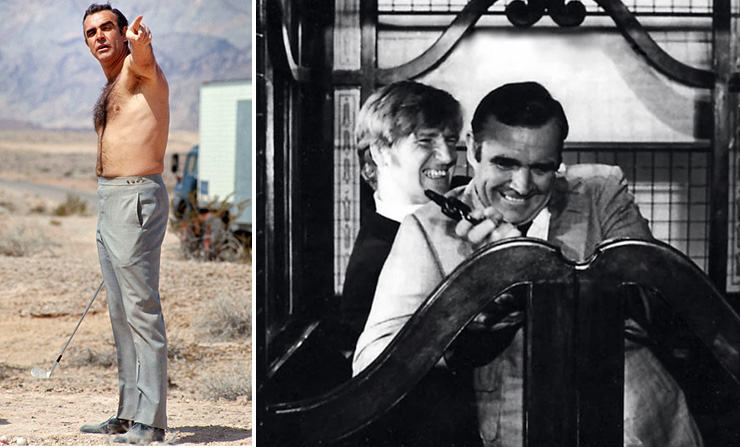 |
|
Sean Connery’s last day of filming was August 13, 1971 - and he celebrated with a game of golf at the nearby Denham Golf Club with Production Designer Ken Adam. Ever the professional whilst working, Connery clearly enjoyed making the film for the most part, although his long-standing feud with co-producer Harry Saltzman resulted in another clause in the actors’ contract that forbade the volatile Canadian to be on set during filming. The production wrapped on August 19, 1971 and editors went to work shaping the final cut. Composer John Barry (along with lyricist Don Black) teamed up once more with singer Shirley Bassey to record the iconic title song. Hoping for a success like their previous collaboration on Goldfinger in 1964, the ‘Diamonds Are Forever’ single only reached number 38 in the UK chart, despite her television performance being viewed by over half the population in a memorable appearance on the Morecambe & Wise show broadcast on BBC1 on Christmas Day 1971. The orchestral score itself was recorded over five days at CTS Studios in London in the last week of October 1971, and is now regarded as one of the high points of John Barry’s eleven James Bond soundtracks (particularly since the 2002 expanded CD release), although the film itself has fared less well with the passing years. With the producers and distributor hoping for a film to rival Goldfinger (the title they both felt was the James Bond template) and with the same director, Diamonds Are Forever was first released in West Germany on December 14, 1971 and then in selected cinemas in New York four days later, then playing in other key European cities and in Australia and Japan the following week. |
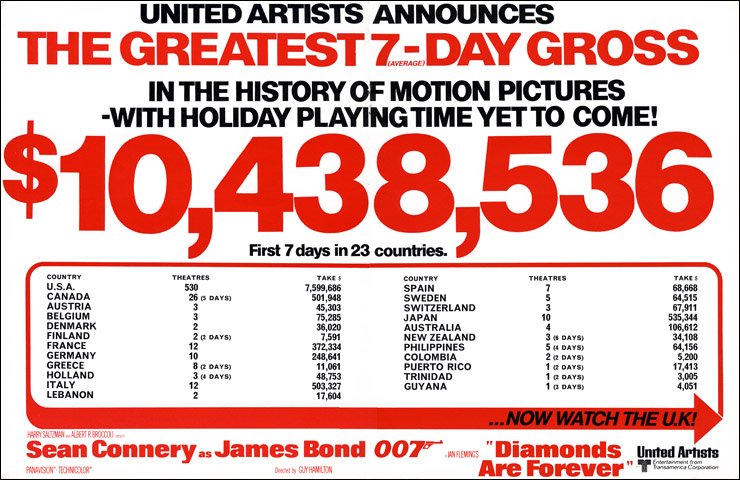 |
|
United Artists’ one million-dollar gamble to tempt back Sean Connery paid off, and they were only too happy to celebrate the huge success of Diamonds Are Forever even before it had opened in the UK. Despite lukewarm reviews in the USA the film made over $2.2-million in its opening weekend (17-19 December 1971) in 58 cities of the USA, Canada, Europe and the Far East; and over $10-million in its first seven days of release. Gary Arnold in The Washington Post hit the nail on the head when he insightfully commented
Gene Siskel in the Chicago Tribune was equally scathing:
|
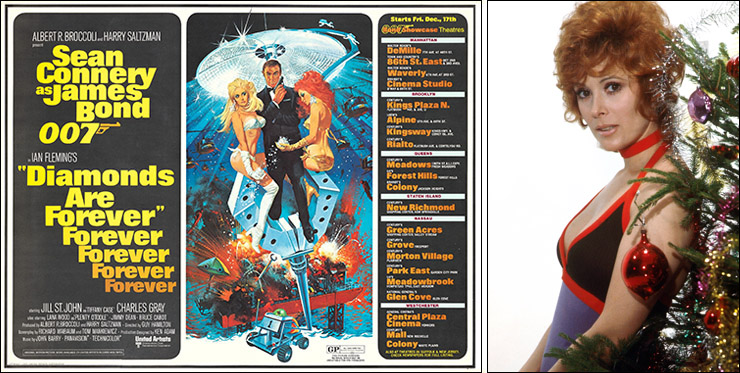 |
|
With many parts of the world seeing the new James Bond film before its UK release, much of the advertising for the film was centred around its Christmas opening in 2,000 cinemas across the USA. Main title designer Maurice Binder had also created a special Christmas teaser trailer which was somewhat redundant by the time Diamonds Are Forever went on general release in the UK in early 1972. |
|
|
|
Very few publicity stills of Sean Connery in character as Bond exist from Diamonds Are Forever as the reluctant star saw little point in promoting himself in the role when it was only for the one film. A series of shots of him wearing an untypical pink tie and holding a revolver, were taken at the Elrod House in Palm Springs; and then a few more of him in a dinner jacket and pointing the piton gun were posed on the backlot at Pinewood Studios. With the incongruous background these were unsuitable as publicity material as they stood, but as a composite overlaid onto an existing photograph of Connery taken on the Vegas strip during filming, one of these shots became the cover of the souvenir brochure available at the Gala Scottish Premiere, and on the back of the PAN paperback tie-in of Ian Fleming’s source novel. The PAN Books paperback film tie-in edition of DIAMONDS ARE FOREVER had a cover featuring concept artwork by Robert McGinnis, arguably superior to the final art seen on the film posters. The final artwork was amended by the artist when it was decided that the figure of James Bond needed to be higher than the two girls. One of the models who posed for the Diamonds Are Forever film poster artwork was noted American feminist Shere Hite (1942-2020). |
|
|